Antiquity 1935 Volume 9 Issue 33 Pages 22-32
Antiquity 1935 Volume 9 Issue 33 Pages 22-32 is in Antiquity 1935 Volume 9 Issue 33.
Stukeley, Avebury and the Druids. By Stuart Piggott (age 24).
There have been few tendencies in the history of English culture with so profound a contemporary influence as the so-called Romantic Movement of the 18th and early 19th centuries, and still fewer with such a strangely assorted progeny. That toying with ‘the Gothick’, which produced such early jeux d’esprit as Walpole’s Strawberry Hill or Beckford’s Fonthill, led, on the one hand, to the Albert Memorial, and, on the other, to the sculpture of Eric Gill; in literature, while the Romantics founded an honourable poetic tradition extending from Collins through Wordsworth to Blunden, it is surely not fantastic to see in such works as Lewis’ Bravo of Venice the genesis of the modern thriller. Most strange of all, one outcome of the Romantic Movement was a new branch of science. For prehistoric archaeology in England was not the product of the classical lore so eagerly absorbed from Italy in the 16th and 17th centuries, but originated in those eccentric gentlemen of the 18th century who perambulated the countryside studying at first hand the antiquities of their own forefathers.
Easily the greatest of these early antiquaries was William Stukeley, and few individuals have left posterity such a mass of potential biographical material. While his published works are relatively few, he zealously kept every scrap of his own manuscript writings, his drawings, the proofs of his published engravings; his correspondence with antiquaries of the day; numerous notebooks, and twenty volumes of his diary, as well as two autobiographical essays. The main bulk of these papers was preserved by his descendants, the St. Johns of Dinmore Court, Herefordshire, and, with some additional material from other sources, were utilized by W. C. Lukis in his edition of The Family Memoirs of the Rev. William Stukeley, M.D. prepared for the Surtees Society in 1882-7. In 1924, some of the Dinmore Court MSS. were presented to the Bodleian1 (which already possessed, in the Gough topographical collections, several important Stukeley MSS.); others were purchased by that Library and by Mr Alexander Keiller (age 45), who has since acquired additional MSS. from time to time.2 With such a plethora of material it is obviously impossible, in the space of a single article, to do more than indicate the main outlines of Stukeley’s life, and to deal in detail with a single, but extremely important aspect of his archaeological work-the apparent mixture, in his published account of Avebury, of sound field-work with so much fantastic theorizing that in popular estimation the second characteristic has swamped the first. Most archaeologists today would probably endorse Tom Hearne’s opinion of Stukeley - ‘He is a very fanciful man, and the things he hath published are built upon fancy’ - but those who have had occasion to check his field-observations know him as an accurate and careful observer. A study of his life and thought as reflected in his own writings shows that this paradox is capable of explanation.
Note 1. Bodleian Quarterly Record, October 1924, no. 43, 149.
Note 2. The writer owes a debt of gratitude to Mr Keiller not only for indicating in the first place the possibilities of the MSS., and suggesting the research of which this paper is an outcome, but for placing them unreservedly at his disposal and giving every facility for their study.
William Stukeley (age 42) and his Wife Frances (age 33). Drawing by Stukeley (age 42) in a MS Genealogy (c. 1730) in the possession of Alexander Keiller.
Frances Williamson: Around 1697 she was born. In Dec 1727 William Stukeley and she were married. In 1737 she died.
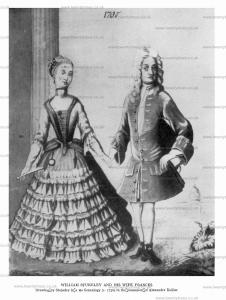
William Stukeley was born in 1687,3 at Holbeach in Lincolnshire, his father, John Stukeley, being a lawyer in partnership with his elder brother Adlard. Engaging glimpses of his boyhood days can be gathered from his memoranda-his learning to write at the age of seven ‘of Mr Coleman who taught us in the Quire of the Church’; or later, being taught to dance ‘among the other young Fry of the Town’; and playing the flute, an accomplishment of which evidence exists today in a volume of flute music which he copied out in 1714.4 We see him listening behind a screen to the conversations between his father and Mr Belgrave - ‘an ingenious Gent’ - on astronomy, and writing an essay to controvert their arguments; making maps of the country round Holbeach, or a puppet theatre in imitation of one he had seen. In 1700 he was apprenticed in his father’s office, but his inclinations did not lie in the study and practice of the law, and in response to his entreaties he was sent to Cambridge to study medicine, where he was admitted a pensioner at Corpus Christi in November 1703.
Note 3. Where the source is not otherwise given, the details of Stukeley’s life are derived from Lukis’ published work referred to above.
Note 4. A.K. MSS.
At Cambridge, Stukeley found himself in a congenial atmosphere. He attended Vigani’s lectures on chemistry, went botanizing in the country around to collect material for a new edition of Ray’s Catalogus Plantarum, and ‘began to conceive a passionate Love for Antiquitys’. He gives a description of his room at Corpus:
‘which had a very strange appearance with my furniture in it, the wall was generally hung round with guts, stomachs, bladders, preparations of parts and drawings. I had sand furnaces, Calots, glasses, and all sorts of chymical implements.... Here I and my Associats often dind upon the same table as our dogs lay upon. I often prepard the pulvis fulminans and sometimes surprized the whole College with a sudden explosion. I cur’d a lad once of an ague with it by a fright’.
One suspects that he was not wholly popular with those who inhabited rooms adjacent to his.
Stukeley’s father died in 1705, his mother two years later, and on his taking his M.B. in 1709 he went to London to study at St. Thomas’ hospital. Before this, however, he paid a visit to friends in Northamptonshire, where it appears that he was not insensible to the charms of his host’s daughter Martha, who
‘had somewhat of an airy temper, and accompanyd me in several of my Rambles in that Country to view Antiquitys, Roman Camps, and the like. We traveld together like Errant Vertuosos, and when we came to an old ruind Castle, etc., we climbd together thro’ every story and staircase, mutually helping one another, and pulling each other over the gaping arches and rugged heaps of rubbish, and when I had occasion to draw a view of them out, as we sat upon a stone or the grass, she held my ink horn or my paper, and was very serviceable and assistant in taking my designs, and all without any reserve or immodesty; nor could any aged Philosophers have conversd together with more innocent familiarity or less guilt even in thought or intention. Nor could travailing curiosity or Antiquarian Researches be rendered so agreeable as with a fair and witty Companion and Fellow laborer, and when we returnd home my young Disciple could entertain the Family with so very curious Relation of the curiositys we had seen, that it would be difficult to say whether so nice taste in the Remains of Ancient Time most recommended a young Lady, or that Refined study became more lovely and delightful for her sake'.
There is a faint tang of bitterness and regret in that brief sentence which closes the episode in his ‘Commentarys’ - ‘She is since marryd to a Gentleman in Wales’.
For the next ten years Stukeley practised medicine; in Lincolnshire at first, but from 1717 in London, where he was in 1720 elected a Fellow of the College of Physicians, reading the Gulstonian Lecture to that body in 1722. His wide range of scientific interests had already secured him a Fellowship of the Royal Society in 1717, but archaeology was rapidly becoming his principal pursuit. His interest in the antiquities of his own country was symptomatic of the feeling among the intelligentsia of his day, for already for some time ‘a number of gentlemen residing in and about London, of like inclination... used to meet weekly, on a Wednesday evening, as a club, at the Mitre Tavern in Fleet Street. Their conversation turn’d on matters of learning, chiefly Antiquitys’.5 On his coming to London in 1717 he was introduced to the club by Maurice Johnson and the next year was largely instrumental in forming the dining club into a more formal body; this in his account of its founding he calls indifferently the Antiquarian Society or The Society of Antiquaries, and under the latter title it has continued to the present day.
Note 5. MS. History of the Society of Antiquaries (A.K.)
The foundation of the Society of Antiquaries, of which Stukeley was the first secretary, marks the real beginning of his archaeological career, during the first ten years of which he made a very considerable contribution to British archaeology. For it was between 1718 and 1725 that he carried out his monumental series of field-observations at Avebury and Stonehenge, without which our knowledge of those great megalithic structures would be materially less. At Stonehenge little destruction took place after his day, but Avebury was wrecked to such a degree that, without his record of its appearance two hundred years ago, we could glean but little from its shattered remnants. Before we come to consider his work on these monuments in some detail, it is well to emphasize one point. Since his entering Cambridge, his training and environment had been essentially that of a scientist. His medical work, coupled with a genuine bent for scientific research so far as it was known at the beginning of the 18th century, would naturally cause him to bring to bear upon the study of antiquities an acute and observant eye; a mind accustomed to diagnosis would grasp the salient points and make cautious deductions from them; while he would appreciate the value of an accurate record of fact both in words and in drawings, the latter made easier by his own considerable talent in sketching (a talent, alas, to which the engravers of his published plates rarely did justice). In fact, Stukeley was one of the first of that large band of medical men who have turned their scientific training to the study of archaeology with excellent effect.
It is commonly thought that Stukeley started his Avebury fieldwork, and to some extent that at Stonehenge, with a preconceived theory dominating his mind-that Hydra-headed, tortuous monster of perverse ingenuity which, in the published accounts of these monuments, is so much in evidence that the solid basis of fieldwork is almost stifled, Laocoon-like, by its involved coils. We shall see, however, that there is no evidence that this was the actual state of affairs.
In the newly founded Society of Antiquaries, Stukeley met and rapidly formed a close friendship with Roger Gale, son of the master of St. Paul’s School. Gale had had access to, and had transcribed some of the manuscript of John Aubrey’s Monumenta Britannica, which at that time was in the hands of Awnsham Churchill, the bookseller and publisher,6 and it seems more than likely that Aubrey’s description of Avebury fired Stukeley and Gale to make an expedition to this site and to Stonehenge in 1718. At all events the journey was made, and in December of that year Stukeley copied Aubrey’s account of Avebury, and his plan, from Gale’s transcript, into his commonplace book.7
Note 6. W. Long, Abury Illustrated (Devizes, 1862), 61. (Reprinted from Wilts Arch. Mag. IV and VII, but with additions not published elsewhere).
Note 7. Commonplace Book 1717-1748, in the library of the Wiltshire Archaeological Society at Devizes.
As Mr T. D. Kendrick has shown, in the only sane book on Druids ever written,8 Aubrey was the first to claim Stonehenge, Avebury and other megalithic monuments for the Druids, and it seems that from this ‘humble submission to better judgment’ as Aubrey himself styled his hypothesis, Stukeley ultimately built his incredible structure of fantastic theory. But in the years immediately following 1718, theory occupied a secondary place: Stukeley was working as a scientist. About this time he was attacked by gout, and rode ‘on horseback in the spring, for recovery of his health. By this means, he indulged his natural love of antiquitys, especially those of his own Country’. In 1721, and 1723, he undertook lengthy tours of southern and midland England with Roger Gale, making numerous notes and drawings which were published as Itinerarium Curiosum, Centuria I, in 1724. But his main work was the fortnight or so of each year devoted to Avebury and Stonehenge, and sufficient material remains (thanks largely to his habit of dating most of his drawings) to reconstruct a journal of his work on the former site, in which his change of mental outlook can be clearly traced.
Note 8. T. D. Kendrick, The Druids (1927), 8.
In May 1719, he made his first ‘rude general sketch’ of the Avebury circles,9 and part of the Kennet Avenue; in 1720 and 1721 he again visited the site, the second time with Roger Gale. In 1722, he made a first draft of a large scale-plan of the circles10 as well as other drawings, and discovered the problematical Beckhampton Avenue.
Note 9. In the Commonplace Book at Devizes.
Note 10. Avebury Drawings (A.K.)
It is in 1722 and 1723 that for the first time we can detect some hint of Stukeley's searching for a theory to account for the lay-out of the circles and avenues. On the manuscript plan of the circles of 'The Remains of the British Temple in the village of Avbury Wilts, Ao 1722' to which we have referred, the two double concentric circles within the main circle are called 'The Lunar Temple' and 'The Solar Temple'; subsequently altered to 'Northern' and 'Southern' temples respectively. On 8 July 1723, he made his well-known drawing of the stone circles of 'The Sanctuary' on Overton Hill, and in its original form called it the 'Temple of Ertha';11 on 19 July he made the drawing of 'A view from the spot of the Temple at the end of Bekampton Avenue '12 His original plans of the sanctuary described below were also in the first instance called 'The Temple of the Earth'. To this year also must belong a great panoramic view of the whole Avebury complex,13 although it is undated. On this drawing, probably Stukeley's finest piece of draughtsmanship, there is indicated a hypothetical circle at the end of the Beckhampton Avenue to balance those on Overton Hill, and against it is written (and subsequently heavily crossed out) 'Temple of the Infernal Regions '.
Note 11. Proof Plates, no. 62 (A.K.)
Note 12. Ibid. no. 61 (A.K.)
Note 13. Avebury Drawings (A.K.)
1724. Stukeley's (age 36) original field-sketch of the plan of the Overton Hill stone circles [Map]. Bodleian Library, M.S Gough Maps 231. f. 54r.
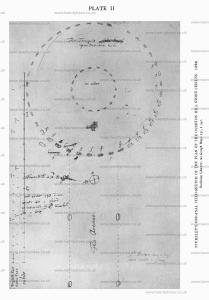
1724. Stukeley's (age 36) original field-sketch of the plan of the Overton Hill stone circles [Map]. Bodleian Library, M.S Gough Maps 231, f. 9v.
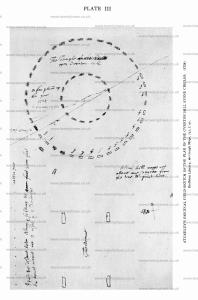
1740. William Stukeley (age 52). For the published plate of the Overton Hill Stone Circles [Map], though not the final version, showing the corcles altered to oval. MS in the possession of Alexander Keiller. See Avebury Chapter VIII.
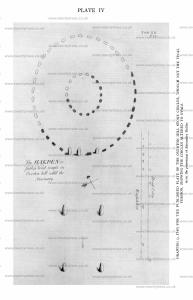
1743. William Stukeley (age 55). Overton Hill Stone Circles [Map]: Plan published in Stukeley's 'Avebury'. Tab XX..
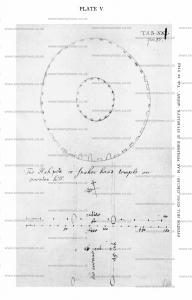
A cosmic theory was obviously in his mind, and this is amplified with regard to the circles at Stanton Drew, which Stukeley visited on 23 July 1723, after he had been working at Avebury for nearly a fortnight. The engravings made from his drawings of Stanton Drew were published posthumously in Centuria II of the Itinerarium Curiosum, where one is called the 'Solar Circle', and in his account of the circles, published in the same volume under the title of 'The Weddings'. and which we know from the manuscript14 to have been written in March 1724, the theory of Solar and Lunar Temples, and the Temple of the Earth, is set forth and compared with Avebury.
Note 14. A.K. MSS.
It is clear therefore, that when first Stukeley began to theorize, it was not his famous Serpentine ideas that filled his head, nor, in fact, does he seem to have regarded his celestial theory with any great seriousness, for he abandoned it in 1724. It is necessary to explain at this point that it appears to have been his custom to have his drawings engraved directly after each yearly visit, and on his next visit he would correct proofs on the spot; increasing shading here, deleting a tree there, or altering the title. The proof engraving of what eventually became tab. XXI of his ‘Abury', (the view of the Sanctuary), was, as we have seen, originally entitled ‘the Temple of Ertha’, but on 18 May 1724, when he was again at Avebury, he altered this to the sensibly non-committal ‘Temple on Overton Hill', fortunately dating the correction on the proof. A similar correction was also made on his original plans of the site. The Beckhampton ‘Temple’ being no longer needed - ‘The Infernal Regions’ being unnecessary with no ‘Temple of Ertha’ - the proof of this view, mentioned above, was altered from ‘Spot of the Temple’ to ‘Near the Spot of the Termination of the Bekampton Avenue’ (Abury, tab. xxv). It is probable that the alterations to the main plan, of ‘Northern’ and ‘Southern’ for ‘Lunar’ and ‘Solar’ Temples were made at the same time.
This year, 1724, was the last at Avebury. Stukeley, unhampered by theories, completed his magnificent detailed record, both in notes and illustrations, of a monument which was being destroyed before his eyes. We owe him a deep debt of gratitude for his Avebury work, and scarcely less for that on Stonehenge which he carried on during the same years, 1718-24. Stukeley discovered the Avenue and the Cursus, and, incidentally, it is to him that we owe the term ‘trilithon’ for the megalithic units at Stonehenge. The dramatic recovery of the Avenue, lost for two hundred years, by air-photography in 1921, was a vindication both of the accuracy of Stukeley’s observations arid of the utility of this recently adopted adjunct to archaeological research.
Any modern archaeologist who has had occasion to test the accuracy of Stukeley’s field-work during the decade 1718-27, will have proved the complete reliance that can be placed upon it. In 1725 Stukeley and Roger Gale made a tour in northern England, the journal of which, entitled Iter Boreale,15 was not published until after Stukeley's death, in the second part of the Itinerarium Curiosum. Mr Crawford has recently shown, in the pages of ANTIQUITY,16 the use to which he was able to put a drawing of the stone circle of Long Meg and her Daughters, made during this tour, in identifying the site of a now destroyed adjacent circle. Instances such as this might be multiplied indefinitely.
Note 15. The original MS. is in the A.K. Collection.
Note 16. ANTIQUITY, 1934, VIII, 328-9 (plates I, 11).
In February 1727, Stukeley wrote to Roger Gale:
‘I begin now and then to peep over my old papers and drawings, and among antiquity matters Abury seems to touch my fancy the most at present, and probably, if business does not too much encroach upon my time, I shall publish it in a year or two'.
Had Stukeley acted on this worthy resolution his reputation today as an archaeologist would have been very different. But, unfortunately, other matters did encroach upon his time, with lamentable results. Neither his leaving London and going to live in Grantham in 1725, nor his marriage in 1728 to Frances Williamson, were likely to pre- judice his archaeological judgment; but in June 1729 he took a step of which the consequences profoundly coloured his whole subsequent outlook.
Despite his scientific training, it is clear that there had always been a strong underlying vein of mysticism in Stukeley’s character, increasing as the years went by. A love of elaborate symbolism and allegory probably accounts for his entry into Freemasonry in 1721,17 and once he had begun to think about Druids his fancy led him into strange paths. He laid out a 'Druidical grove and temple' in his garden at Grantham, and in 1728 he buried a still-born child
... 'under the high altar in the chappel of my hermitage vineyard; for there I built a niche in a ragged wall overgrown with ivy, in which I placed my roman altar, a brick from Verulam, & a waterpipe lately sent me by my Lord CoIrain from Marshland... there we enterred it, present my wives mother & aunt, with ceremonys proper to the occasion'.
It is perhaps surprising, after this semi-pagan ritual, to find him writing in June 1729, to his friend Dr Wake, Archbishop of Canterbury, asking his advice and help in the matter of ordination for the church, and hinting darkly that his Druidical researches had led him to 'some notions about the Doctrine of the Trinity, which I think are not common'. He was apparently more explicit in a letter to Roger Gale, to such a degree that that worthy man was seriously alarmed at his friend’s decision, for he wrote back urging a reconsideration. 'Your reconciling Plato & Moses', he goes on, '& the Druid & Christian Religion may gain you applause, & perhaps a Patron; but it is good to be sure of the latter upon firmer motives than that scheme may inspire people with at present'. But Stukeley was not to be deterred. He had decided that every pagan religion, particularly that of the Druids, was a foreshadowing, not only of Christianity, but of the doctrine of the Trinity, and with this weapon he was going to battle against the sceptics in 'this age of epidemical infidelity'. And so we see him ordained in November 1729, and appointed to the living of All Saints, Stamford.
Note 17. For Stukeley’s masonic career see R. F. Gould in Ars Quatum Coronatorum, vi.
Fired with all the misguided enthusiasm of the religious revivalist, Stukeley’s first task was to utilize his field-work of the last ten years as ammunition in his holy war. Poor Avebury was the first victim of this transforming process. Gale writes in June 1730 to congratulate Stukeley on his resumption of work on the Avebury book, and declares himself 'much pleased with the plan of your theological1 enlargements upon it'. Enlargements they certainly were, and in a letter in reply on 25 June, Stukeley reveals their true nature.
'The form of that stupendous work [Avebury] is the picture of the Deity, more particularly of the Trinity.... A snake proceeding from a circle is the eternal procession of the son from the first cause.... My main motive in pursuing this subject is to combat the deists from an unexpected quarter, and to preserve so noble a monument of our ancestors’ piety, I may add orthodoxy'.
Stukeley had indeed plunged deeply into the waters of religious controversy. Scepticism was at this time becoming fashionable under Hume and the younger Dodwell, having developed out of the early forms of Deism of Chubb, Tindal and Toland. Now Toland, in addition to his more obviously controversial religious works, had written a diffuse and involved History of the Druids, containing scarcely veiled attacks on ‘priestcraft’ in general, which was published posthumously in 1726, and is more than once referred to by Stukeley in his published accounts of Avebury and Stonehenge. It is possible that Stukeley’s attack on Deism through the Druids may have been tinged with some personal feeling against the unfortunate Toland, more particularly when we find that about 1710 Toland had published his Origines Judaicae, in which he ridiculed one Huetius, who in a work entitled Demonstratio Evangelica, had sought to prove that various Old Testament characters were allegorized in heathen mythology (including, rather unexpectedly, Moses as Bacchus)-a scheme not unlike Stukeley ’s own theories.
After this we are less surprised than we might be to find that, when Stonehenge was finally published in 1740 it was graced with a preface explaining that it, and the forthcoming Abury, were to be considered merely as parts of a great work entitled ‘ Patriarchal Christianity, or a Chronological History of the Origin and Progress of true Religion, and of Idolatry’. He had decided, he says, to publish Stonehenge and Abury first, ‘ and proceed to the speculative parts afterwards; reserving them, God willing, to the maturer time of my life ’. ‘ My intent is ’, he goes on
'to warm our hearts into that true sense of Religion, which keeps the medium between ignorant superstition and learned free-thinking, between slovenly fanatic- ism and popish pageantry, between enthusiasm and the rational worship of God, which is no where upon earth done, in my judgement, better than in the Church of England’.
And so we find that odd and incongruous mixture in the published accounts of Stonehenge and Avebury - sound field-work and careful observation side by side with the wildest imaginative flights, according to whether Dr William Stukeley or the Rev. William Stukeley was the dominant mental character at the moment. So far as can be seen, enough remained of his scientific conscience to prevent him from materially altering the facts to fit his theories, but in one instance at all events he was guilty of a very grave crime in this direction.
His published plan (Abury, tab. XX) of the destroyed stone circles on Overton Hill, known as ‘The Sanctuary’, shows them not as circles, but as ovals (PLATE V). As Captain and Mrs Cunnington’s excavations of 1930 proved, they were in fact true circles (Wilts. A.M. XLV, 300). After this discovery, Stukeley’s reputation as a field-archaeologist seemed likely to wane, but it is fortunate that in the Bodleian there are two original field-sketches of this plan,18 and in both the circles are drawn as circles, and even some of the ‘extra’ stones near the junction with the Kennet Avenue, the sockets for which were found in 1930, are shown (PLATES II, III). The intermediate link between these excellent plans and the misleading published record of the site is provided by an original drawing c. 1740 which, while not that from which the plate was engraved, comes very close to it in detail19 (PLATE IV). In this the stones (or stone-holes) are arranged as ovals in grey wash, but are superimposed on a faint pencil outline showing them as circles, while in one of the original plans a rough oval outline has likewise been sketched. We can only feel that Stukeley, by now completely theory-ridden, thought how desirable it would be to give his snake an oval, more naturalistic, head, and so committed the serious offence of altering his original survey.
Note 18. MS. Gough Maps, 231, 9v 54r.
Note 19. Avebury Drawings (A.K.)



After the publication of Stonehenge in 1740 and Abury in 1743, Stukeley’s archaeological career, though pursued with enormous vigour, is the melancholy record of the decay of a once-sound mind, It was in 1747 that he received the letter from Charles Bertram of Copenhagen, which ultimately led to his accepting as genuine the famous forgery of Richard of Cirencester, the story of which has been told in these pages by Mr H. J. Randall.20 His subsequent archaeological productions were a most involved farrago of far-fetched hypotheses, coupled with an almost infantile credulity. The career of Carausius had long interested him, but unfortunately he misread FORTVNA on a coin as ORIVNA, and thereupon in a moment of inspired lunacy produced a wife of this name for his hero, announcing his momentous discovery in print in 1752. Windmill Street near Piccadilly he concludes quite rightly to have been called after an actual mill - but he goes on to assume that as windmiils sometimes stood on barrows, a barrow therefore existed in Piccadilly Circus in which the king of the Trinobantes was buried!21 Such instances may have an almost pathological interest to the student of mental aberrations-to who respect Stukeley’s earlier work they are pathetic.
Note 20. ANTIQUITY, 1933, VII, 49-60.
Note 21. MS. entitled Knaves Acre, written c. 1760 (A.K.)
He died in 1765 at the age of 78, being at that time rector of St. George’s, Queen’s Square, Holborn. His work during the ten years from 1718 shows him to have been the finest field-archaeologist that England had so far seen or was to see for a century; for the next thirty-five he was instrumental in propagating theories the very imbecility of which seems to have endeared them for ever to the public mind. Who shall apportion praise or blame to so contradictory a character?